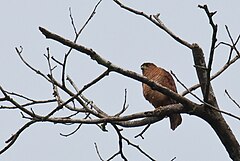Tiny Hawk
| Tiny Hawk | |
|---|---|
 | |
| rufous morph immature | |
| Conservation status | |
| Scientific classification | |
| Kingdom: | Animalia |
| Phylum: | Chordata |
| Class: | Aves |
| Order: | Falconiformes (but see there) |
| Family: | Accipitridae |
| Genus: | Accipiter (disputed) |
| Species: | A. superciliosus |
| Binomial name | |
| Accipiter superciliosus (Linnaeus, 1766) | |
| Synonyms | |
Falco superciliosus Linnaeus, 1766
Hieraspiza superciliosa (Linnaeus, 1766) (but see text) | |
The Tiny Hawk is a small diurnal bird of prey found in or near forests, primarily humid, throughout much of the Neotropics. It is primarily a bird-eater, and is known to prey onhummingbirds.
Usually named Accipiter superciliosus, it is the only species of the genus Accipiter yet studied which has a large procoracoid foramen. It also differs from the typical sparrowhawks in other respects of its anatomy and in its DNA sequence. Consequently, its old name Hieraspiza superciliosa may be more appropriate.
Taxonomy
There are two subspecies of Tiny Hawk, separated by the northern Andes. The two differ most significantly in relative tail length; differences in size and color are small, and can be hard to distinguish.
- A. s. superciliosus is found east of the Andes in South America. Slightly the larger of the two subspecies, it is paler and has diffuse, grayish barring on the underparts.
- A. s. fontanieri is found from Nicaragua down to western Ecuador. It is somewhat smaller and darker than the nominate A. s. superciliosus, with a shorter tail and sharper, blacker barring below.
The Tiny Hawk and its sister species, the upland-dwelling Semi-collared Hawk ("A." collaris), form a superspecies.
Description
The Tiny Hawk is aptly named; males measure a mere 20 cm (7.9 in), about the size of astarling, though females are slightly larger at 26.5 cm (10.5 in). It is one of the smallest true raptors in the world and is one of the smallest Accipiter species, though the Little Sparrowhawk of Africa is of similar or even smaller size. The birds range in weight from 75 to 120 g (2.6 to 4.2 oz) As with most raptors, there is considerable sexual dimorphism in size, with females measuring up to 25% longer and as much as 60% heavier than males.
The adult male Tiny Hawk is dark slaty gray above, with a mottled gray face, a paler gray supercilium, and a blackish crown and nape. The white underparts are covered with fine gray barring, except on the unmarked throat. The longish tail is dark with three paler gray bands. Adult females are similar, but browner above with buffier underparts and browner barring below.
Immature birds come in two color morphs: the brown and the rufous. Brown morph birds are dark sooty-brown above, finely barred with black, and white below, heavily barred with cinnamon. Rufous morph immatures are more chestnut above, and barred with rufous (rather than cinnamon) on the underparts. They also have duskier heads and brighter rufous tails than do brown morph birds.
The cere and legs of all ages are yellow, and the bill, which is relatively heavy, is gray. Adults have red or red-brown irises, while those of immatures often are yellowish.
Unlike most accipiters, the Tiny Hawk's tail is quite short; it is squared or notched at the tip. Its wings are medium-length, with pointed tips, and its legs and toes are long.
Habitat and distribution
Tiny Hawks are patchily distributed from eastern Nicaragua down to western Ecuador, northern Bolivia, northern Argentina, Paraguay and southern Brazil. They frequent humid and wet lowland forests (including second growth) and forested foothills from sea level to about 1800 meters (5900 ft), though most records come from elevations below 1000 m (3300 ft).
The species is believed to be fairly sedentary.
Behavior
On clear mornings (and occasionally in late afternoons), the Tiny Hawk will sometimes sun itself on a high open branch. Occasionally, pairs will sun together. Otherwise, this is a secretive species and easily overlooked. It generally hunts from a perch, located anywhere from the undergrowth to the canopy, though most often in the middle story. When hunting in low growth, it often flashes from one perch to another in rapid succession. It is a fast flier; instead of the typical flap-flap-glide cadence of the accipiters, it makes a few quick flaps and then briefly closes its wings before flapping again. Tiny Hawks occasionally soar above the forest canopy.
Diet
Like all accipiters, the Tiny Hawk feeds primarily on birds. It hunts hummingbirds and small passerines, typically darting out from a place of concealment to snatch them as they pass by, but also ambushing them when the smaller birds are perched. There is some evidence that it learns the regular perches of some hummingbirds and hunts for them there. Some individuals also hunt rodents.
Breeding
Little is known about the Tiny Hawk's breeding biology. Their breeding season may vary depending on their location; from Panama toColombia, it apparently runs between February and June, while in the southern part of the range, it may range from October to January.They are known to build stick nests, at least sometimes in the canopy of tall trees. In Venezuela, there is a record of a pair nesting in an old Black-collared Hawk nest. Females lay one to three bluish-white eggs, faintly streaked and spotted with brown. Incubation and fledgingperiods are not known.
Vocalization
The call of the Tiny Hawk is a shrill, high-pitched, somewhat quavery series of 20–30 notes of uneven pitch. After an initial few accelerating notes, the call settles into a steady rhythm, variously transcribed as caucau-ca-ca-ca, keer-keer-keer or kree-ree-ree-ree.

2 comments:
Pet animal is very entertainment to human brochure printing services Update more
Thank you for visiting.
Post a Comment